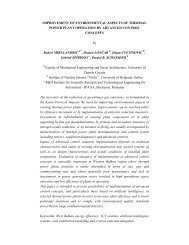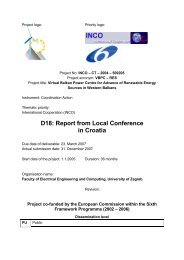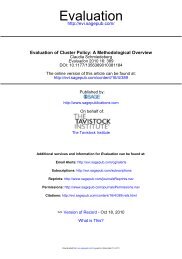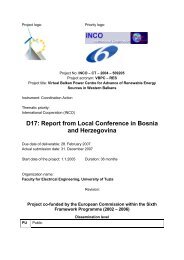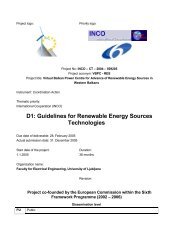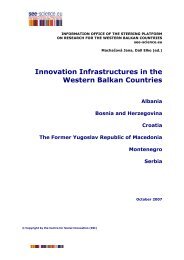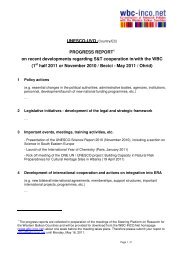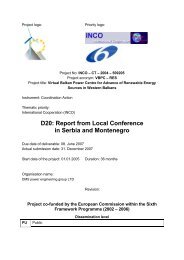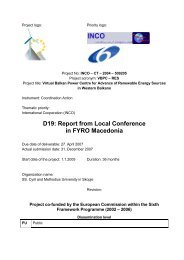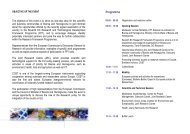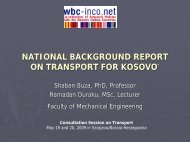Prva stran - WBC-INCO Net
Prva stran - WBC-INCO Net
Prva stran - WBC-INCO Net
Create successful ePaper yourself
Turn your PDF publications into a flip-book with our unique Google optimized e-Paper software.
energy resource, which is distributed widely. Biomass<br />
energy sources include agriculture crops straw, firewood,<br />
excrements of human beings and animals, organic<br />
wastewater from industry, city garbage and city sewage. The<br />
exploitable amount of biomass resources is about 700·10 6<br />
Mtce (metric tons carbon equivalent). Among them, the<br />
straw and stalks contribute 120·10 6 Mtce and firewood some<br />
90·10 6 Mtce, [6].<br />
The biomass resources are rich in South-West of China,<br />
especially rich in Sichuan province because of its high<br />
forecast bestrew rate, but it is less in North-West of China.<br />
Now China is performing the ecological and environmental<br />
protection engineering and activities, aimed to protect<br />
natural forest and to return infields and grass. In the future,<br />
this measure could provide more biomass, as the quantities<br />
of straw and domestic waste will increase too. It was<br />
estimated that by the year 2010, the straw and domestic<br />
waste will increase by 100 % and 160 % of the levels in<br />
1995, respectively. Biomass energy should therefore be<br />
listed as the first priority on renewable energy development<br />
strategy of GHG mitigation in China. Tab. 4 gives the<br />
obtainable amount of biomass resources in three provinces<br />
of WRC, as determined in their Renewable Energy<br />
development plan.<br />
TAB. 4<br />
THE OBTAINABLE BIOMASS RESOURCES IN THREE PROVINCES OF WRC<br />
Guangxi Sichuan Gansu<br />
Total<br />
(10 6<br />
Mtce)<br />
Per<br />
capita<br />
(Mtce)<br />
Total<br />
(10 6<br />
Mtce)<br />
Per<br />
capita<br />
(Mtce)<br />
Total<br />
(10 6<br />
Mtce)<br />
Per<br />
capita<br />
(Mtce)<br />
Straw 7.54 1930 24.18 3530 2.56 1240<br />
Firewood 4.31 1110 6.97 1020 1.02 490<br />
Waste 6.18 1590 14.49 2120 0.81 390<br />
Total 18.03 4630 45.64 6670 4.37 2120<br />
E. Geothermal Energy<br />
According to China National Standard (GB11615-89),<br />
the geothermal energy resource can be classified to three<br />
levels by temperature: High temperature (t ≥ 150 0 C), middle<br />
temperature (90 0 C ≤ T < 150 0 C) and low temperature (60 0 C<br />
≤ T < 90 0 C, 40 0 C ≤ T < 60 0 C and 25 0 C ≤ T < 40 0 C). Most of<br />
the geothermal energy in China is middle- and low<br />
temperature resource. The proved geothermal resources are<br />
9.251×10 19 J/a (3,158·10 6 Mtce/a). Of more than 2,900<br />
geothermal fields in mainland China, there are more than<br />
1,600 geothermal fields, which have been explored and<br />
utilized, [6], [7]. It is also worth noting that the operation<br />
and maintenance costs of the geothermal power plant are<br />
lower than diesel oil power plant.<br />
Most of the high temperature resources are distributed in<br />
Himalayas geothermal region of Tibet. With 255 proved<br />
high temperature geothermal sources distributed throughout<br />
the province, Tibet is leading in geothermal applications of<br />
China. The total installed capacity of geothermal power<br />
plants in Tibet is 28 MW. In Yang Bajing power plant of<br />
Tibet, the installed capacity is 25.18 MW. According to<br />
Geothermal Special Committee of China Energy Research<br />
Commission, the total geothermal energy potential resources<br />
amount at the depth below 2000 meters is 5,800 MW, Tab.<br />
5.<br />
TAB. 5<br />
THE DISTRIBUTION OF GEOTHERMAL ENERGY RESOURCE IN WRC<br />
Province Proven Resources Prospective Resources<br />
Area<br />
(km 2 )<br />
Minable<br />
amount<br />
(10 12 KJ)<br />
Area<br />
(km 2 )<br />
Minable<br />
amount<br />
(10 12 KJ)<br />
Yunnan 107.73 2,644 18,528 377,995<br />
Tibet 35.87 512<br />
Shanxi 11.85 28<br />
Qinghai 1.0 16<br />
Xinjiang 147,400 2,865,672<br />
China Total 10,149 92,510 257,047 3,962,319<br />
IV. CONCLUSION<br />
While the least developed of the Chinese regions, the<br />
Western Region of China (WRC) has significant renewable<br />
energy potential. Its development could aid China’s efforts<br />
toward sustainable development and energy independence,<br />
while at the same time supporting China’s efforts for control<br />
of greenhouse gas emissions during its phase of intensive<br />
development and industrial growth.<br />
[1]<br />
V. REFERENCES<br />
EC (1997): "Energy for the Future: renewable sources of energy";<br />
White Paper for a Community Strategy and Action Plan; COM(1997)<br />
599 final(26/11/1997).<br />
[2] EC(2001a) Directive 2001/77/EC of the European Parliament and of<br />
the Council of 27 September 2001 on the promotion of electricity<br />
produced from renewable energy sources in the internal electricity<br />
market.<br />
[3] EC (2000a) "Green Paper on security of supply in Europe", European<br />
Commission; (COM(2000) 769 final).<br />
[4] AMR(Academy of Macroeconomic Research),NDRC(National<br />
[5]<br />
Development and Reform Commission): “Energy Research of<br />
Sustainable Development in WRC”, Dec.2002<br />
Su Zhengmin, Renewable Energy Development and Rural Energy<br />
Construction in WRC, Dec.2002, AMR(Academy of Macroeconomic<br />
Research) Report.<br />
[6] China New Energy and Renewable Energy White Paper, 2002<br />
[7] Zhang Zhengmin, Wang Qingyi ,Zhuang Xin et al. Renewable<br />
Energy Development in China The Potential and Challenges Beijing:<br />
Coal Industry Press, 2002<br />
[8] Ren Xiang General Situation of Geothermal Resources of China,<br />
Informal Report, 2002<br />
VI. BIOGRAPHIES<br />
Xu Xiangyang received her Diploma Science degree, Master of<br />
Business Management and Dr.Sc. in 1983, 1991 and 2000, respectively<br />
from Tian Jin University, China University of Mining and Technology<br />
(Beijing) and Beijing Normal University of China. She spend a year as Post<br />
Doctor in Energy Research Group(EEG), Vienna University of<br />
Technology, Austria in year.2004-2005. She was Research Scholar (part<br />
time)in IIASA (International Institute for Applied Systems Analysis),<br />
Austria from Feb.2004—Feb. 2005 . Since Jan.,2005, She is energy and<br />
environmental consultant of ACM( Austrian Carbon Management),<br />
Austria. She was employed as associate professor of China University of<br />
Mining and Technology (Beijing) since Dec.1998 to present. Her major<br />
interests are modeling energy and environment problems, mainly focus on<br />
China, clean energy choice and sustainable development strategy of China<br />
and research on CDM projects.<br />
Su Zhengmin received her Diploma from Economics and Management<br />
Department of Beijing University,China. She is the deputy researcher of<br />
Energy Research Institute of National Development and Reform<br />
Commision of China. She have participated and in Charged of many<br />
projects including international cooperation projects,such as China rural<br />
energy projects, renewable energy project of West Region of China,<br />
CETP(China Energy Technology Programm) project of ABB, Swissland,<br />
Japanese projects(Forecast on China Energy supply and demand analysis<br />
3



